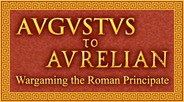I am working on a Roman cavalry ala (wing) at the moment. It involves re-using half a dozen figures I painted during my first, abortive, attempt at this project from a few years ago, plus a batch of fresh castings. You can see the painted figures, as they were before I threw them in the stripper, in A&A Miniatures Product gallery. They're about half way down the gallery, and have small round red shields.
I have found that B&Q's 'Brush Restorer' (£2.98 for 500 ml) is a good way to strip metal figures. It contains organic solvents, inclduing Dichloromethane, so it's not pleasant stuff, and I wouldn't use it on plastic figures (polystyrene cements, such as EMA Plastic Weld, often consist of mostly Dichloromethane), but it works a treat on metals. Chuck the figures in a jar, pour in enough brush restorer to cover them, pop the lid back on, agitate slightly, and then leave for an hour or so. After that, whip 'em out of the pot, and bung them in the sink with a lot of warm water and scrub with an old toothbrush - the paint should come straight off.
Ala Gaetulorum veterana was stationed in Syria during the Second century AD, so there's a fair chance it may have been around in the Third too. It was originally recruited from the Gaetuli, a tribe from Western North Africa - so the troops were presumably of roughly Numidian/Moorish/Berber ethnic type. By the Third Century, I doubt if any of its members actually came from the unit's place of origin, but the name gives me the excuse I need to use a little 'wargamer's licence' and utilise A&A Miniatures' 'Moorish Light Cavalry' models. It should create a little variety in the Roman force. I'm going to use hexagonal shields with Little Big Men Studios' MIR(A&A)21 shield transfers. They should look nice alongside the dark skins on the men.
Right, that should be long enough for the paint-stripper to have worked, so I'll go and get on with them.
